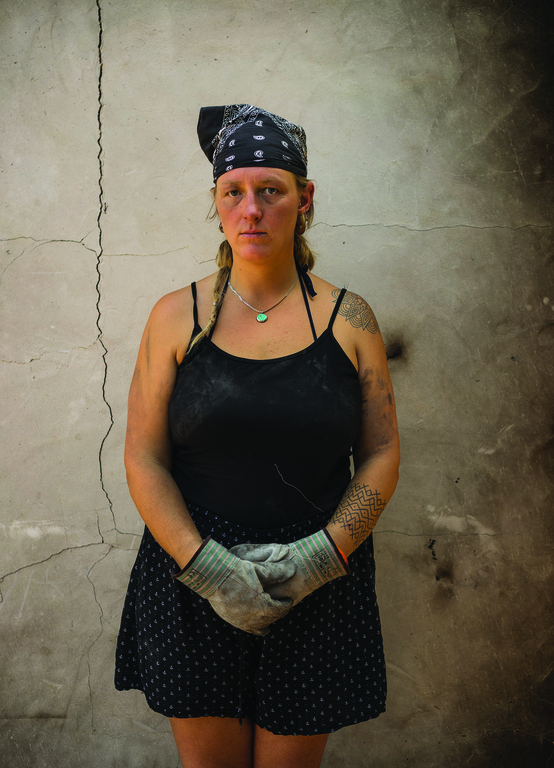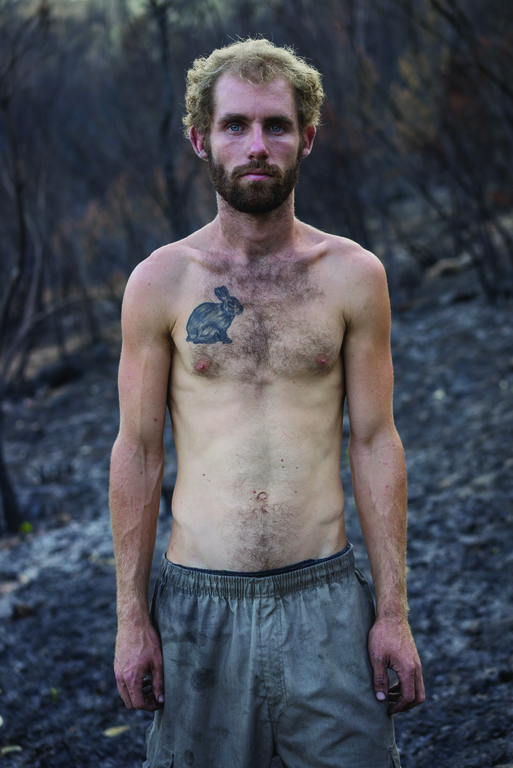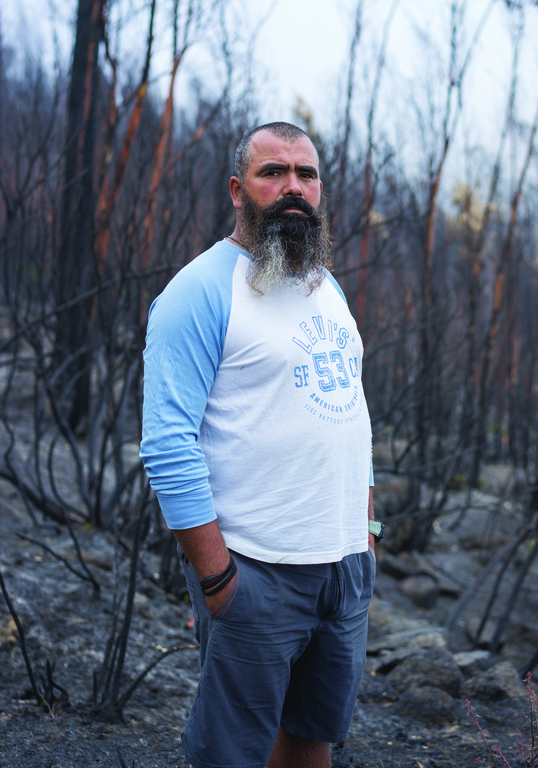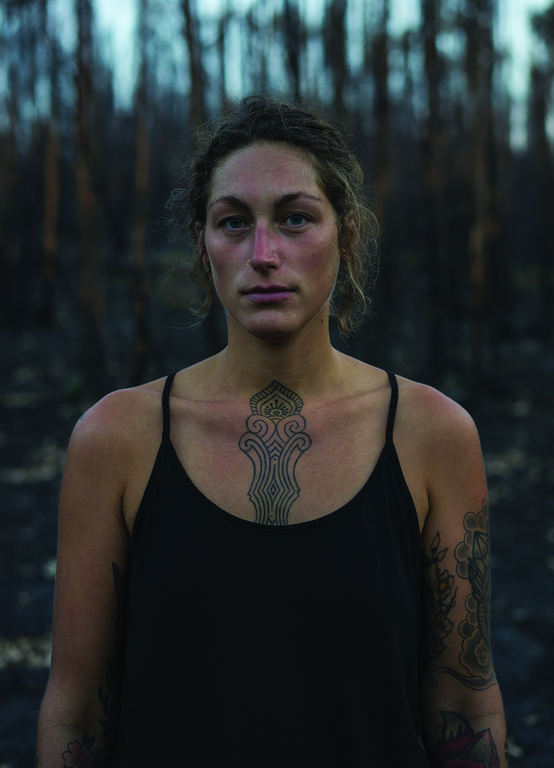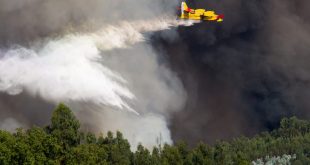What did you lose and what did you gain from the fire?

The Karuna Retreat Centre has been totally devastated. Basically, all the structures that existed there disappeared. The forest disappeared. I feel that a fire, when it comes in a natural way, cannot cause so much devastation. If we look 360 degrees around us, Karuna is surrounded by eucalyptus trees on all sides. We have more or less three hectares. We had cleaned everything: there were no eucalyptus, all the medronho trees had been pruned and the weeds had been cleared around them. So there was no reason for the fire to devastate the four quite large buildings that formed the Karuna Centre, from the temple to the dining room, from the dormitories to the house where the people stayed.
In the 2003 fire. I saw helicopters trying to work, I saw responsible people inside those helicopters commanding things. Monchique people. On the 5 and 6 of August this year, I didn’t see a single helicopter. I didn’t see a single fire engine across Picota. This is not natural. We should have seen a helicopter pass by, shouldn’t we? We should have seen them passing by to fetch water. I didn’t see anything.
We have to take some exceptional measures, to protect houses and forests in the future with an emergency system. We have to take care of things. What we have gained from this fire is the awareness that things are extremely unbalanced and that it is necessary to store water and protect ourselves better because this will continue to happen.

I came on Sunday 5 August, and when I arrived at Pé da Cruz, where there was a police blockade, I decided to go up on foot. And what I saw in the afternoon, after lunch, was clearly total disorganisation, a lack of command. I went inside fire engines, GIPS cars. Whoever was in command of this part of Picota took no concrete action at that time.
There were water-tankers pouring water onto the road; I saw a blockade further up. There was no command, there was no one in charge. It seems that it was done on purpose to generate confusion and to show a lack of coordination. There are things I will not talk about here. I will leave them for the future, maybe in court. Very serious things. It is my intention now to connect with other people and sense what can be done, for example, to change the eucalyptus mind-set.
Those who defend this policy are people who may perhaps be older, people who maybe don’t live in the area, who see it as a form of income. One must try to explain or demonstrate that it is possible to have an income without resorting to the production of eucalyptus, an income that is taken care of for them.

Since we do not have many hectares, we didn’t lose many. We had seven, so six burned.
It was the first time the fire came so close to the town – never in any generation had this ever happened before. When the fire arrived at that hill, it very soon got to the health centre, to the street itself. It burned a little of the hedge in Rua da Nossa Senhora da Conceição and entered the town.
Those of us who are responsible for the territory don’t know how to look after anything that the previous generations have managed to maintain: trees that are hundreds of years old and, above all, water, the deep water tables, which are collective property. This fire made me realise that, years before, fountains that had never dried up now had no water, fountains where we found a cork oak that had been there for generations and where everyone who passed by used to drink.
If we need to drill a hole, we have to fill out a lot of papers in the town hall, ask for a permit … and we’ll probably get no for an answer because you cannot drill a hole in the water table, only a previously existing well can be legalised. And although a new hole cannot be made, because water is a collective asset, millions of holes are allowed, from “straws” called eucalyptus, which are legally sucking water from the water table (and each eucalyptus probably sucks more water from the water table than an individual borehole for the supply of a house). And this is what surrounds Monchique.
Therefore, the fountains that existed on the land and where water flowed for generations, in summer and winter, have lost this water that should be feeding chestnut trees, cork oaks, poplars, alders, all this moisture that traditionally characterised the mountains. .. Something is absorbing it.
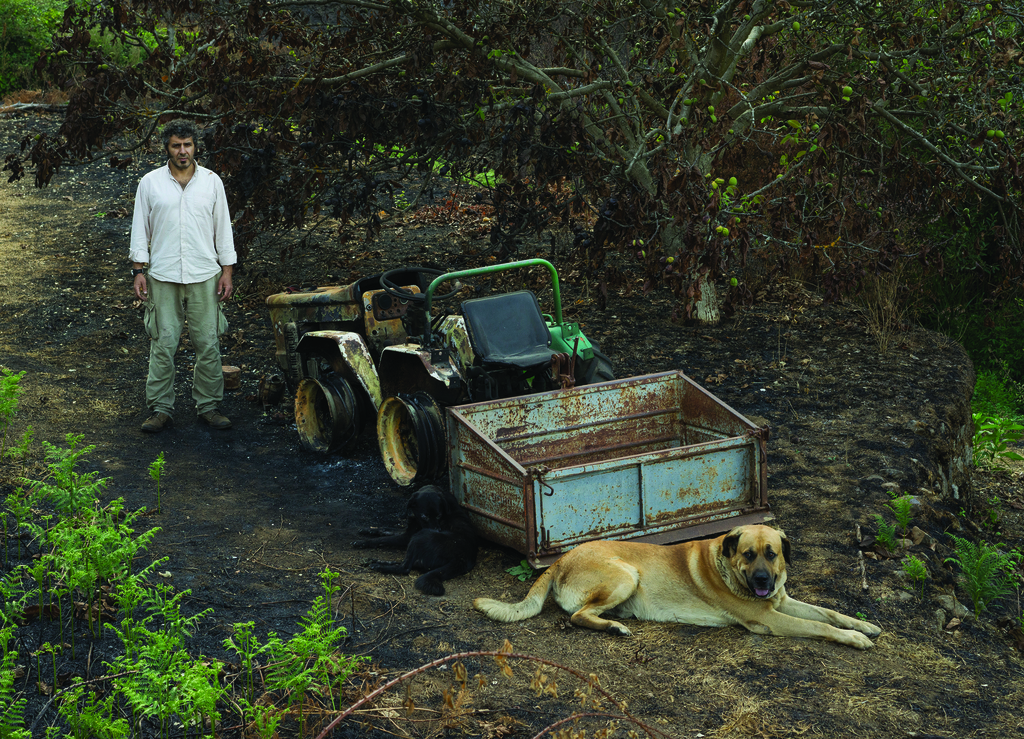

Does Civil Protection take responsibility?

Rui Lopes, aged 48,is married and has two children. ECO123 spoke to him at Monchique fire station about the fires, causes and responsibilities.
Who was responsible for fighting the Monchique fire?
I was in command on the 3 August (Friday) until the end of the afternoon. The fire began that day, around 13:34. In the first 14 minutes, there were 204 firefighters operational in the field and at night, 639. On Saturday morning, 763 breakfasts were served to all those present: firefighters, GIPS, GNR, among others.
Who was in charge? The Mayor or the Command of the Civil Protection Service?
Always the Civil Protection and at the start, with the commander Vítor Vaz Pinto*. The command post was initially installed at Altura das Corchas. Then, on Saturday, when the fire took on a different dimension, the command post was installed at Monchique Heliport. The second national operational commander, Patrícia Gaspar, was there from Sunday.
On the evening of Sunday 5 August, the new municipal councillor, José Chaparro, spoke on television, criticising the immense confusion that existed in the fight against the fire, between the commanders of the District and National Civil Protection Agencies and the firemen. Citizens criticised firefighters, who had been waiting for orders to put out fires for at least five hours and had done nothing.
On the Sunday, when the fire reached the town? That can’t be true.
We investigated. Our witnesses reported that the fire was under control on Saturday 4 August. Firefighters were already back at Monchique fire station when the wind changed direction and the fire restarted with much more force. There were no firefighters in Caldas de Monchique, or in Alferce or Fornalha on the Sunday night. All the villages in the Picota area were abandoned without any support.
Wasn’t this a very serious error in the evaluation of the fire and in the choice of the strategy to fight the flames?
That can’t be true. On Saturday at 1:40 p.m., the aerial surveillance by helicopter, ordered by Mayor, Rui André, and the Civil Protection commander, Vítor Vaz Pinto, came to an end. The fire was not completely put out, but almost. Then the wind changed. The fire reignited again heading back to Perna da Negra and, once again, towards Foz de Carvalhoso. But the fire was almost out on Saturday night into Sunday. When the fire entered the area of Ribeira de Seixe on Sunday, there was a very strong wind and the fire took on enormous proportions.
The fire entered an area with a lot of flammable material…
Yes, eucalyptus and a lot of badly maintained shrubs and a lot of wind. The eucalyptus forests on the site had not been cleaned. The fire also gained strength and speed because there was so much combustible material.
Was the confusion between Vítor Vaz Pinto and Patrícia Gaspar?
I don’t know. I was ill and I left on the evening of Friday 3 August. I know that Vítor Vaz Pinto was in service on 3, 4 and 5 August and that Patrícia Gaspar came in on 5 August and stayed until 7 August.
The Karuna Centre burned and there wasn’t a single fireman! Corte Grande burned. There were no firefighters to protect a forest with 2,00-year-old trees; the same thing in Alferce. We can continue and count the losses for each hour.
That’s right. In my opinion, we are still very much caught up in the issues of combat, when all else fails. What about forest management? The year’s coming to an end, and in four months we’ll be back on high alert. What has been done within this time frame? Nothing!
And who is responsible for this situation?
The government. When prevention fails …
…the Municipal Council?
The Municipal Council, the Portuguese State, everyone.
That is, Rui André and António Costa?
So let’s see. When the State fails, there is a Head of State and a Prime Minister, right? I have been a firefighter since 1991. I lived through fires in 1991, 1995, 2001, 2003, 2004, 2016 and now in 2018. What has been done in terms of land-use planning and forest management (the first pillar)? What has been done about the creation of non-eucalyptus zones, the planting of native species of hardwoods – oak, for example? Nothing! And the second pillar: prevention and vigilance? In the area above Perna da Negra, more or less in the area of Sol Branco, we found a huge stack of wood that eventually altered the condition of the road. The sheer heat prevented us from passing with our vehicles. We needed to get a bulldozer to clear a path. This is risky behaviour! Why do woodcutters cut eucalyptus and not take away the remaining wood? Selling the wood means selling the whole tree. Nobody authorises them to leave the waste on the ground, this poses a great risk. In three or four years’ time, we will have the same problems again.
Firefighters lose the battle against almost every major fire. How do you feel? They lose the fight, they lose equipment, they lose their lives …
Do they feel like losers?
We can’t fulfil our mission. That’s what we feel.
May I write and publish these words, Commander?
Yes, we haven’t been able to fulfil our mission with 22 men under contract and 40 volunteers who aren’t able to work when they’re helping to put out fires (Monchique has an area of 397 km2 and 76% of the forest is eucalyptus monoculture, remark of the autor). If the community were much more interested and ready to participate in prevention, it would be stronger. We wouldn’t be looking for guilty people.
No, and what about those who should be responsible?
Yes.
What is it like living with the memory of these disasters?
We won the battle against 68 fires in 2018, but we lost this great battle. How do we extinguish fires with temperatures of 45 degrees Celsius, 10 to 14% humidity and winds of 60 to 80 km per hour, when the air forces were unable to put out the fires on Monday 6 August due to the smoke? We need to be realistic. Firefighters also need to rest after a certain amount of time at work. They can’t recover 100% of their energy after a few hours’ rest. In other words, with so many days of fire, it is always going to be a very big fight.
Thank you.

Taking the State to court?

A tragédia do incêndio da Serra de Monchique de Agosto de 2018 gerou danos cuja gravidade é em grande medida incalculável. Tanto ao nível material – pela floresta ardida, pelos bens destruídos, pelas culturas desaparecidas, pelas casas inteiras carbonizadas, pelas próprias infraestruturas de serviço à população, tais como rede eléctrica e de telecomunicações, que ficaram em grande parte danificadas, com consequências até ao presente – como ao nível moral, para toda a população local e nacional.
Em termos colectivos, os danos ao nível ambiental assumem proporções verdadeiramente catastróficas, com destruição de uma vastíssima área de floresta, queima e desequilíbrio de ecossistemas, e aniquilamento de património ambiental e cultural de enorme relevância a nível nacional e até mundial – nomeadamente com destruição de locais privilegiados, bosques de árvores autóctones com centenas e até milhares de anos de antiguidade – e produção de fumo e dióxido de carbono poluente em alta escala.
Ao nível a actuação jurídica e judicial, coloca-se a questão da reacção por parte dos cidadãos afectados, e de toda a comunidade, numa busca de tutela contra aquilo que foi uma verdadeira tragédia patrimonial e ambiental, mediante a implementação de acções com vista à obtenção de ressarcimento de danos, e à imposição de medidas de fiscalização e cumprimento da lei em vigor, a fim de se prevenir a ocorrência de novos desastres semelhantes.
Face à exiguidade dos meios de resposta – nomeadamente ressarcitórios – anunciados pelo Governo, e tendo em conta a enorme burocratização e dificuldade de acesso mesmo aos escassos meios disponibilizados à generalidade da população, a actuação judicial apresenta-se como a única forma eficiente para obtenção de tutela e defesa de direitos fundamentais dos cidadãos, e do património ambiental destruído.
Vem sendo verificado com cada vez maior clareza que o gigantesco incêndio foi determinado por um composto de factores imputáveis à conduta humana, situadas quer ao nível da falha de prevenção e fiscalização da legalidade na gestão ambiental e florestal, quer ao nível da própria reacção e actuação dos serviços competentes de protecção civil. E que ele não teria existido com esta dimensão e consequências não fora a negligência e ineficácia dos serviços públicos responsáveis, e não fora a ganância pela maximização de lucro a todo o custo.
Tendo em conta os objectivos distintos a prosseguir, afigura-se que a actuação judicial deveria desenvolver-se em dois âmbitos e dois processos ou complexos processuais principais distintos:
a) o da obtenção de ressarcimento justo para o conjunto de cidadãos e empresas afectados pela tragédia – incluindo proprietários, empresários, agricultores – de forma a compensá-los pelas perdas patrimoniais e morais sofridas na sua esfera privada, e na possibilidade de desenvolvimento das respectivas actividades económicas;
b) o da imposição de fiscalização e reposição da legalidade ao nível das práticas de gestão florestal e ambiental no Concelho e em toda a Serra de Monchique, mediante uma actuação colectiva ou popular capaz, também, de obter um adequado ressarcimento de danos ambientais, para aplicação na recuperação da Serra.
O primeiro objectivo implica um levantamento dos danos patrimoniais e não patrimoniais provocados aos cidadãos e empresas afectados (incluindo lucros cessantes em virtude do impedimento à prossecução das actividades económicas e produtivas), e, bem assim, pela concretização e demonstração das falhas, actuações e omissões que determinaram o incêndio e as suas trágicas proporções.
Imprescindível será a seriação, de forma objectiva, de omissões ou actos concretos integradores de uma ou mais formas de conduta ilícita – contrária às normas e princípios aplicáveis – e da sua relação causal com o incêndio, com as proporções que ele assumiu, e por conseguinte com os danos que dele decorreram. Com efeito, o desiderato ressarcitório implica a demonstração, perante o Tribunal, da verificação cumulativa dos pressupostos da responsabilidade civil.
A preparação do processo implicará, assim, uma actividade de recolha de elementos probatórios para apresentação em juízo, incluindo prova testemunhal, prova documental, e relatórios técnico-periciais com análise das causas e consequências da tragédia.
O processo judicial em causa poderá ser instaurado por todo o conjunto de cidadãos e empresas afectados, quer mediante simples actuação conjunta (em litisconsórcio ou coligação activa) quer mediante a constituição prévia de uma associação de lesados, entidade sem fins lucrativos, capaz de actuar em representação dos lesados – para o efeito deverá incluir essa finalidade no seu objecto.
A actuação por meio da associação teria a possível vantagem de beneficiar de uma isenção de custas, o que, dependendo do valor indemnizatório a peticionar, poderia revelar-se como uma medida de significativa importância económica. A questão da legitimidade activa da associação a criar, para este tipo concreto de pedido, aproximaria o processo de uma espécie de “class action” – não se tratará propriamente de uma acção popular, por visar ainda uma tutela de interesses individuais agrupados ou homogéneos – ainda sendo necessário clarificar os termos e concreto alcance da recepção desta figura no nosso ordenamento jurídico, a fim de se confirmar a sua eficácia como instrumento válido para este objectivo em particular.
O segundo objectivo constituirá já uma actuação em sede de verdadeira e própria acção popular – à qual a lei reconhece benefícios ao nível das custas judiciais independentemente de se actuar como associação ou não – em defesa do ambiente e do ordenamento do território, pela qual se pode impor o cumprimento das normas aplicáveis e, também aqui, peticionar uma indemnização pelos danos ambientais verificados, correspondentes ao referidos interesses difusos, que não são apropriáveis individualmente.
Esta organização dos meios de actuação em duas fases ou dois complexos processuais, parece ser a que mais claramente traduz as diferentes formas de tutela pretendidas, e os objectivos específicos a prosseguir com uma e outra.
A actuação judicial ao nível ressarcitório e reintegratório não exclui a instauração de processos de natureza criminal, ou intervenção como assistente(s) em processos-crime existentes, caso a investigação em curso o justifique.
E nenhuma delas exclui as formas de tutela negociais, administrativas e políticas pelas quais os cidadãos interventores possam complementar a suas actuação em prol dos lesados, da defesa da Serra de Monchique e da salvaguarda da floresta e do meio ambiente.

Loose reflections in a context of fire-rights
After an immediate reaction of deep anguish and dismay, people gradually began to reflect… without a timeline or a deep sense of depression, but calmly, since mourning will fade into memory, leading to a more objective and active phase in our lives.
What about the need to take legal action in the case of the fire in Monchique? Several situations have made us poorer, more dispirited, and all this from one day to the next. It’s worth studying this a bit.
How did we behave in the face of the fire? Did we act in defence of our possessions? Were we somehow prevented from doing so? Did we delegate this role to others? Without unnecessary sophisms, novels or criticism, it is worth thinking objectively to identify the reality of what we are living through.

We must also reflect on the behaviour of others. We, the others, the organisations responsible, how did we prepare for a fire that was predictable? Did we all know the strategy resulting from the fire prevention plan? What practices were developed before the fire? And how were they put into action at the time of the calamity in which the fire roared through the municipality? What benefits did the declaration of a Public Disaster bring to the injured parties? Have the injured parties been recognised by the Civil Protection authority, or other authorities, as victims? Most citizens do not individually have the means to combat problems in power structures (their power wouldn’t even fit into a drop of water), but the strength of the ‘people’ together can ‘move mountains’!
The phenomenon of fear that swept the community of Monchique and the anguish that was associated with it made it fall asleep… We know that a lack of reflection leads to misinformation, frustration and the creation of phantoms that don’t bring any good. It is necessary, therefore, to take action! To end the general lack of information and criteria that are unsuited to the particularities this territory and to put an end to the special privileges that a select few have been enjoying.
This reflection is not directed at anyone in particular, but it is possible to work out people’s relative positions and establish connections in the web of events. There were failures! It’s not a drama, it’s essential to clarify everyone’s behaviour.
To encourage the behaviour of those who pretend to be doing something, so that nothing actually happens… to distribute money so that nothing is done … is thoroughly reprehensible when there are citizens left with nothing, who need effective supportsuch as a simple document …
To think that what happened was a freak accident, without taking any responsibility for what happened, is an unforgivable distraction that shows no respect for anyone, from the simple citizen to the human being that exists in each one of us: the municipality, the technicians, the civil protection services and the Portuguese State.
To look closely at the Municipal Plan for the Defence of the Forest against fire, drawn up by the Monchique Municipal Committee, 2016-2020, is to be confronted with a patchwork of technical details that means little to the common citizen, that speaks of a Monchique to be found somewhere in the territory, with only limited staff and not very dynamic, in a text that is full of commonplaces.
• If the rivers and streams flow unchecked down into the basin of Portimão, why is nothing being done to clean these streams and build small dams or other structures to conserve the water and increase the humidity of the land during the summer period, thus avoiding these seasonal extremes?
• If south-facing land is drier and has less combustible material, leading to lower moisture content, which greatly increases the likelihood of large fires spreading, why not focus more on prevention, surveillance and means of combat in these areas? Why not act together from a perspective of knowledge sharing, informing each other about the comparative behaviour of various plant species; explaining essential factors of development, such as the water consumption necessary for their survival, nutrients, propagation, fuel production …
• In this and other municipalities, it is questioned whether “accidents occurring in the networks of electric power lines” may ignite fires. What preventive measures have been taken? Is risk behaviour being monitored? What tests have been done to avoid such occurrences? Was maintenance of the power distribution lines carried out? During the fire last August, on land near the Health Centre, a lamppost’vomited’ incandescent matter, but as the ground was damp and people intervened, it didn’t spread …
• The municipality should adopt strategies resulting from other examples of readjustments in the organisation and protection of the public or private institutions that constitute its territory, in terms of prevention, surveillance, detection and inspection, in effective planning, management and control of the relief operations and, in the first instance, the protection of the population.
• It is the mayor, as a political leader, who is responsible for this reinforcement of fire prevention measures and the protection of the forest (not only of the eucalyptus), in the promotion and coordination of measures designed to protect the population. If the objective of the plan was to reduce the number of fires in 2018, limiting the area burned to 0.8% of the forest surface is frankly out of touch with reality, as 16,766.52 hectares of land were burned in the Monchique municipality. 32 houses were destroyed (12 of which were completely gutted); 37% of the region’s undergrowth was burned, 34% of the eucalyptus trees, 10% of the cork-oaks, 7% of the stone pines and a similar amount of broad-leaved trees, 4% of agricultural land and 1% of the wild pine trees. A conflagration!
• Not to mention the Municipal Master Plan created in 1993, and revised in 2008, which is clearly inadequate and the cause of numerous problems for citizens.
The population is growing smaller and is ageing. How can its growth be encouraged effectively?! Why not develop meaningful ways of keeping tourists in the municipality? In order to appreciate Monchique’s natural and unique heritage, tourists want to experience the true identity of the region, not words from a virtual reality. If “The Forest is an essential heritage for the sustainable development of a country”, why are we still confusing forest with the eucalyptus monoculture? Which leads to the whitewashing of an association that is showered with constant benefits, leaving the other “forest” without any support.
87% of the territory of Monchique belongs to the Natura 2000 Network, 46% is composed of eucalyptus. However, this network aims to “contribute to ensuring biodiversity through the conservation of natural habitats and wild fauna and flora in the European territory of the Member States.” Where’s the consistency?! Aren’t the experts responsible for such incongruities?!
These and other reflections should be present in our minds. It is urgent to discuss today in preparation for the future, before the next fire arrives, which could be tomorrow! It is necessary to create structures that can defend us in this State of Portugal, governed by the rule of law, to create mechanisms to safeguard our rights and our assets. Why join a legal defence organisation? First of all, to know the stories of those who were harmed, to express, our solidarity with others; after this, to exercise our rights to exert pressure on the powers that be.
We would all benefit from the formation of a non-profit association to defend our rights or, in order to minimise human resources, from the association of the problems of those whose lives have been destroyed by fires to an already existing organisation.
Because together we will be stronger and united.
 Eco123 Revista da Economia e Ecologia
Eco123 Revista da Economia e Ecologia


